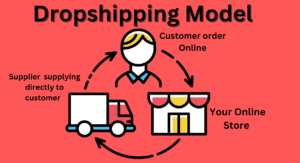“Kickstart your dropshipping journey with low costs, simple steps, and strategies for long-term success.”
Dropshipping has become one of the most popular business models for entrepreneurs who want to start an online store without the hassle of inventory management. In this guide, we’ll walk you through everything you need to know about starting your own dropshipping business. Whether you’re just starting or looking for ways to improve your existing store, dropshipping offers a low-risk opportunity with the potential for high rewards. With no need to purchase stock upfront and the flexibility to run your business from anywhere, dropshipping is an excellent option for those looking to enter the world of e-commerce. Let’s see how you can turn this opportunity into a profitable venture.
1.What is dropshipping?
Dropshipping is a business model that lets you sell products online without having to keep or manage inventory. When a customer orders, you purchase the item from the supplier, who ships it directly to the customer. This method allows you to launch an online store with low startup costs because you buy the products only after they sell them.

2.How does Dropshipping Work?
A step-by-step guide:
Dropshipping may seem overwhelming at first, but breaking it down into manageable steps makes it much easier to understand. Here’s a simple guide to help you understand how it works:
1. Choose your NICHE
Start by choosing a specific category of products to sell. Focus on something that interests you or has a proven demand. The right niche will help you stand out in the crowded online marketplace.
2. Find a reliable supplier
Partner with a reliable supplier who will handle product fulfilment and shipping. To find the right fit, you can explore platforms like AliExpress, Oberlo, or direct suppliers in your area.
3. Set up your online store
Choose an e-commerce platform like Shopify or WooCommerce to build your online store. These platforms make it easy to design a user-friendly website, even if you need to be tech-savvy.
4. Add product and set price
List the products you want to sell in your store, with descriptions, images and pricing. Be mindful of your pricing strategy, considering both the supplier’s costs and the profit margin you want to maintain.
5. Market your store
Attract potential buyers by promoting your store. Use social media marketing, paid advertising (like Google or Facebook ads), and search engine optimization to increase traffic and generate sales.
6. Process orders and handle customer service
Once customers place orders, you will send them to your supplier for fulfillment. Your job is to ensure smooth communication with your customers, handle any issues, and provide excellent service to build trust and loyalty.
By following these steps, you can set up and run your dropshipping business with confidence and clarity. Adding visual aids like infographics or flowcharts can help make the process more digestible for your readers, showing some steps clearly.
3. Choosing the Right Niche
Selecting the right location is one of the most important steps to starting a dropshipping business. Your theme defines what type of products you will sell, what type of customers you will target, and ultimately, the success of your store. A well-chosen niche helps you stand out in a crowded market and makes it easier to connect with your audience.
Focus
A specific niche helps you focus your marketing efforts on a particular customer group, making it easier to tailor your products and messaging.
Less Competition
Targeting a specific market reduces competition compared to trying to sell to a broader, highly saturated market.
Brand identity
Specializing in a particular field makes it easier to build a strong brand that resonates with a particular group of buyers, thereby creating customer loyalty.
Tips for finding a profitable niche
Research trends Use Google Trends to identify popular products and topics. This helps you discover emerging markets and understand search trends. Find high-demand, low-competition keywords with Google Keyword Planner or Ubersuggest. This can help you find sales-potential product categories. Check the Competition: Check out your potential competitors. If you see a lot of stores without a unique approach, this is your chance to change that.
4. Finding Dropshipping suppliers
One of the most important aspects of running a successful dropshipping business is partnering with trustworthy suppliers. These suppliers will handle product inventory and shipping, so making sure they are reliable is key to keeping your customers happy. There are many platforms where you can find suppliers, and it is important to know how to evaluate them.
Platforms for finding suppliers:
AliExpress
A popular choice for beginners, offering a wide range of products at competitive prices. Many suppliers are located in China, so shipping times may vary.
Website:-aliexpress.com
SaleHoo
Salehoo is a website featuring verified suppliers, wholesalers, and dropshippers, offering a vast array of reliable and secure options for various industries.
Website:-salehoo.com
Oberlo
Oberlo, a website integrated with Shopify, enables users to find suppliers and import products directly into their store, offering features like product tracking and order management.
Website:-shopify.com
Wholesale2B
Suppliers are listed on the website Wholesale2B, which integrates with eCommerce platforms like eBay and WooCommerce, providing access to thousands of products and inventory updates.
Website:- wholesale2b.com
BrandsGateway
Brandsgateway, a major eCommerce platform in Australia, offers access to high-end luxury fashion brands from Europe and Australia, integrating seamlessly with major platforms.
Website :- brandsgateway.com
Dropshipzone
Dropshipzone, an Australia-based website, connects customers with local suppliers offering fast shipping and a wide range of products from Australia-based suppliers.
Website:- brandsgateway.com
There are many other websites, and these platforms are excellent starting points for finding reliable dropshipping suppliers for your Australian business. Depending on your niche and shipping requirements, you can explore a combination of local and international suppliers.
5. Checklist for evaluating dropshipping suppliers:
Before starting dealing with any supplier, it is important to complete your checklist with important points as follows:
Shipping time
Make sure the supplier can deliver the products on time. Long shipping times can lead to unhappy customers and poor reviews.
Product Quality
Always ask for samples to assess the quality of the products. Reading reviews from other sellers can also give you information about the quality of the supplier’s product.
Supplier Reviews
Check out feedback and ratings from other businesses that have worked with the supplier. Reliable suppliers usually have a strong reputation for consistency and communication.
Communication
You need to be able to communicate easily with your supplier. A sensitive and clear communication channel is essential to resolving any issues that may arise.
Return Policies
Understand the supplier’s return and refund policies to avoid problems with unhappy customers. Make sure they are consistent with the policies you plan to introduce.
6. Setting up a dropshipping website
Properly setting up your online store is one of the most important steps to building a successful dropshipping business. This is where your customers will browse, buy, and interact with your brand, so it needs to be professional, easy to use, and optimized for search engines.
Here are some examples of online platforms to help you create a website. Its not necessary for an IT professional to design your website because these platforms have built-in guidance to build your website.
Choosing a Platform:
The first step in setting up your store is to decide which platform to use. The two most popular options for dropshipping are:
Shopify:
Known for its user-friendly interface, Shopify is a popular choice for beginners. It offers a wide range of themes and apps to help you customize your store and make it easier to manage your dropshipping business. Shopify also integrates with Oberlo, a tool specifically designed for finding dropshipping products.
WooCommerce:
If you’re familiar with WordPress or want more control over your site, WooCommerce is a great option. It’s highly customizable and allows you to make changes to almost every aspect of your store, but it may require more technical knowledge than Shopify.
Both platforms have their advantages and disadvantages, so choose that suits your skill level and the amount of control you want over your store .Explore more options available online and choose wisely.
Importance of User-Friendly Design:
The design of your store plays a huge role in whether visitors stay there or make a purchase. Here are some key elements to keep in mind:
- Your store should be easy to navigate with clear menus and well-organized product categories.
- Slow websites drive customers away. Make sure your site loads quickly by using optimized images and keeping unnecessary elements to a minimum.
- With more and more people shopping on their smartphones, your store needs to be mobile friendly. This means your website should look great and work smoothly on any device.
By choosing the right platform , design, and user experience, you’ll establish a strong foundation for your online store. A well-optimized store not only attracts visitors but also turns them into customers.
7. Common Mistakes to Avoid in Dropshipping
Drop shipping has its challenges, just like any other business. Many beginners make mistakes that they could have avoided, which may negatively impact their customers or waste their money. Here are some tips to avoid these mistakes:
1. Underestimating shipping costs and time
- Long shipping times, especially from overseas suppliers, can lead to underestimation and customer dissatisfaction.
- There should be clear and timely communication with the supplier
- Offering products from suppliers closer to the main customer base can reduce delivery time and costs.
- Offering different shipping options allows customers to choose faster delivery.
8.Customer Service
Customer service is important for businesses, as they don’t have direct control over the quality of the product. It’s essential to be responsive to queries, keep them updated about orders, and be visionary in resolving issues. By prioritizing client service, businesses can build trust with their guests, icing a positive character and a competitive edge.
9. Choosing the wrong product
Selling fashionable items can be challenging without researching demand or competitors. Certain trends can cause markets to become saturated and unprofitable. Do research before introducing new items. Analyze the competition using Google Trends and evaluate how easily you can differentiate yourself from other merchants in that industry.
10. Ignoring marketing
Dropshippers assume setting up a store is enough to start selling, but without promotion, their store will go undetected. Using organic traffic alone to launch your business might take time. Develop an SEO, paid advertising, and social media marketing strategy. Track which strategies perform best and focus on them to increase traffic and sales via analytics.
Knowing and avoiding these frequently occurring mistakes can help you operate a successful dropshipping business. Maintain a proactive approach, provide exceptional customer service and keep pace with market developments to stay ahead.
Frequently Asked Question & Answer
Q1: What is dropshipping?
Answer: Dropshipping is a business model where you sell products online without keeping inventory. The supplier ships directly to your customers.
Q2: How does dropshipping work?
A: You set up an online store, list products, and when a customer makes a purchase, you order from a supplier who ships the items directly to the buyer.
Q3: Why is dropshipping low-risk?
A: You don’t need to purchase inventory upfront, which reduces financial risk.
Q4: How do I choose a niche?
A: Pick a niche based on your interests and market demand. Research trends and competition to ensure there’s potential for success.
Q5: How can I find suppliers?
A: Use platforms like AliExpress, SaleHoo, and Dropshipzone to connect with suppliers. Verify their reliability by checking reviews and product quality.
Q6: What are common mistakes to avoid?
A: Avoid underestimating shipping times, neglecting customer service, choosing trendy products without research, and ignoring marketing.
Q7: How do I ensure long-term success in dropshipping?
A: Build strong supplier relationships, focus on customer service, keep up with trends, and consistently improve your marketing strategies.
Also Read:-top10hitnews.com


